Research interests
My general research interests lie in numerical methods for PDEs and integral equations, inverse problems, scientific machine learning, and approximation theory. More generally, my background is in numerical analysis and scientific computing. I highlight below my contributions to the following four topics:
- Inverse Scattering Problems;
- Boundary Element Methods;
- Neural Network Approximation Theory;
- Spectral Methods.
▶ Inverse Scattering Problems
Background
A typical inverse scattering problem is the identification of the shape of a defect inside a medium by sending waves that propagate within. In the data acquisition step, several sensors record the medium's response that forms the data of the inverse problem; in the data processing step, numerical algorithms are used to recover an approximation of the shape from the measurements. What I have just described is an example of active imaging, where both the sources and the sensors are controlled during the acquisition step. In passive imaging, only sensors are employed and the illumination comes from uncontrolled, random sources. In this setup, it is the cross-correlations between the recorded signals that convey information about the medium through which the waves propagate. While there were many techniques available for inverse scattering problems in active imaging, only linearization approaches had been developed so far in passive imaging.
Results
In 2023, my colleagues and I presented an extension of the linear sampling method for solving the sound-soft inverse acoustic scattering problem with randomly distributed point sources. The theoretical justification of my sampling method is based on the Helmholtz–Kirchhoff identity, the cross-correlation between measurements, and the volume and imaginary near-field operators, which we introduced and analyzed. The resulting method gives comparable results to the standard linear sampling method with deterministic sources.
In 2024, we extended it to the case of data generated by small random scatterers—a seemingly simple yet powerful model of a random medium that allowed us to apply the linear sampling method in a novel manner.
In 2025, we generalized it to handle random refractive indices modeled by stationary Gaussian processes.
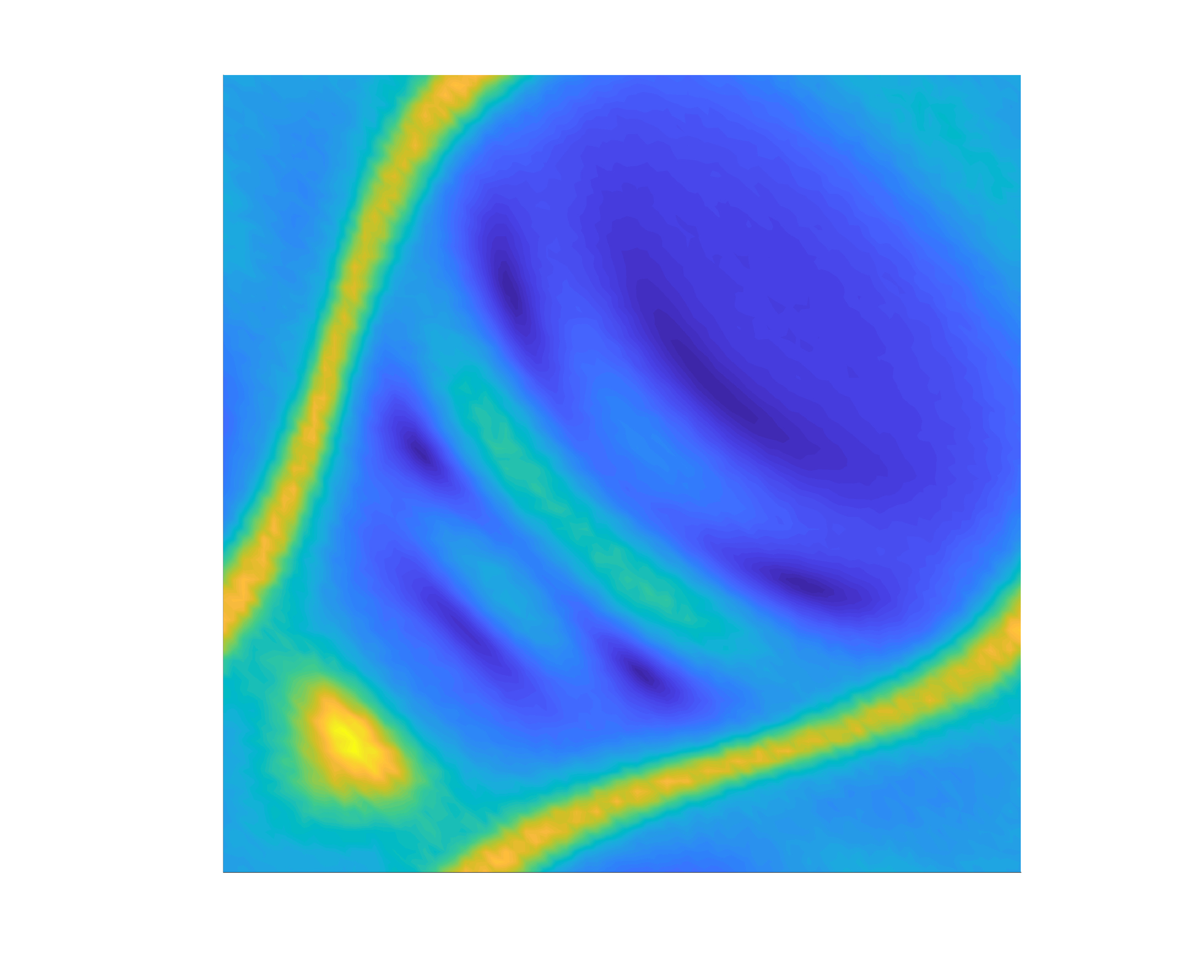

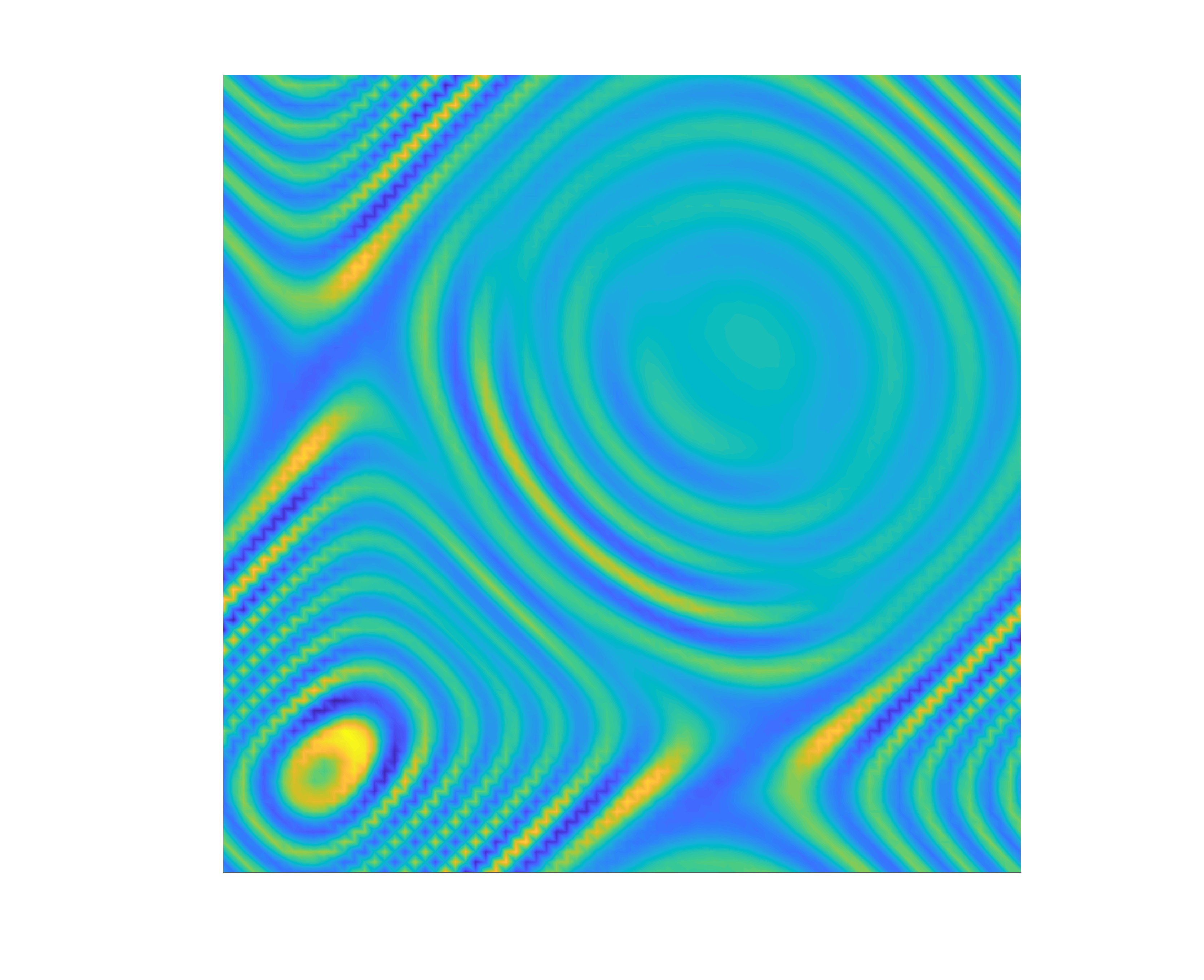
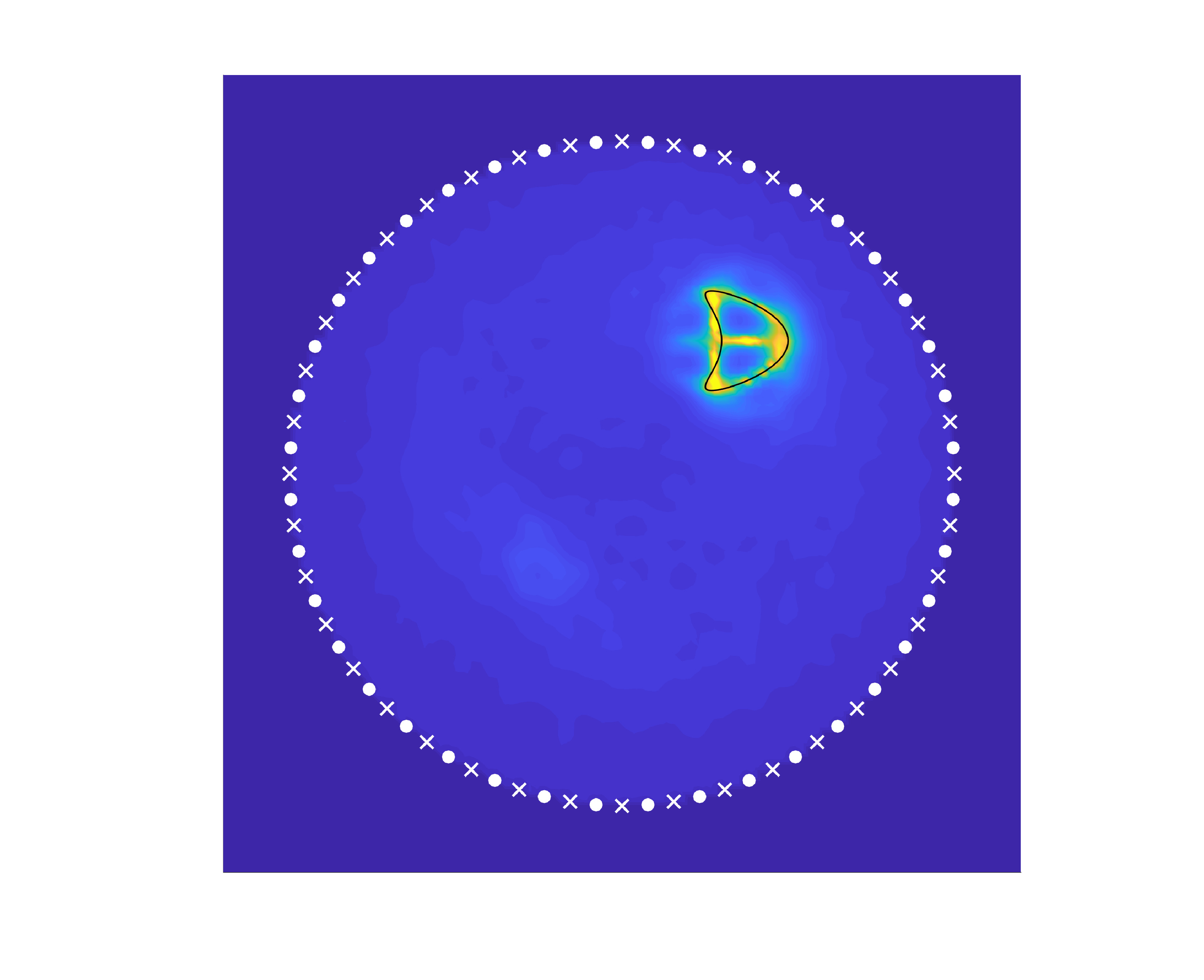

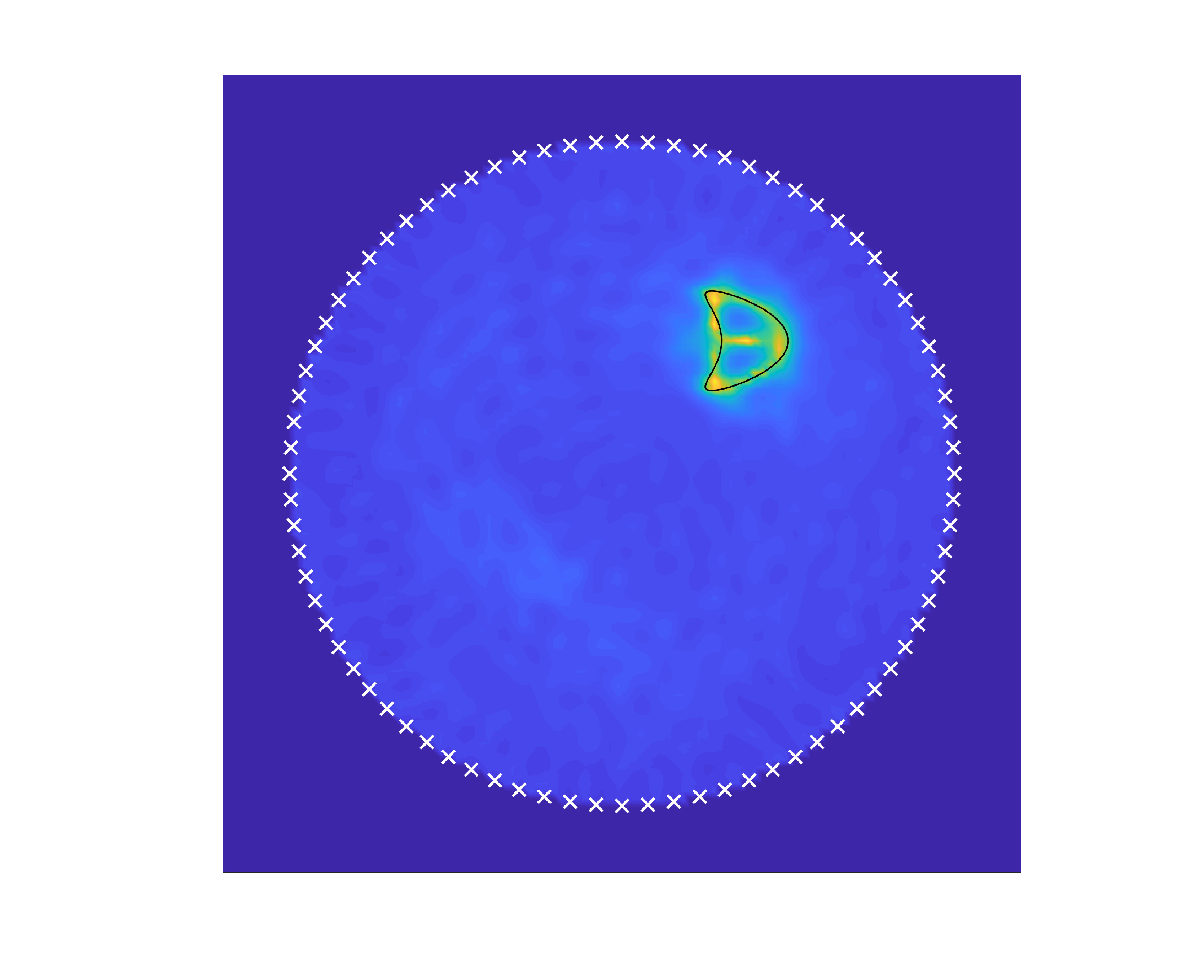
Collaborators
Josselin Garnier (École Polytechnique), Laure Giovangigli (ENSTA), Houssem Haddar (Inria)
Software
lsmlab — MATLAB package for solving inverse acoustic problems with the LSM
Papers
2025 The linear sampling method for data generated by random refractive indices (in prep.)
2024 The linear sampling method for data generated by small random scatterers doi arXiv
2023 The linear sampling method for random sources doi arXiv
Blog posts
2025 The linear sampling method for data generated by random refractive indices (in prep.)
▶ Boundary Element Methods
Background
The Helmholtz equation \(\Delta u + k^2u = 0\) in the presence of an obstacle may be rewritten as an integral equation on the obstacle's boundary via layer potentials. For example, the radiating solution to the exterior Dirichlet problem \(\Delta u + k^2u = 0\) in \(\mathbb{R}^3\setminus\overline{D}\) with \(u = u_D\) on \(\partial D\), for some bounded \(D\) whose complement is connected, can be obtained via the equation $$ \int_{\partial D}G(\boldsymbol{x},\boldsymbol{y})\varphi(\boldsymbol{y})dS(\boldsymbol{y}) = u_D(\boldsymbol{x}), \quad \boldsymbol{x}\in\partial D, $$ based on the single-layer potential; \(G\) is the Green's function of the Helmholtz equation in 3D. Once the integral equation is solved for \(\varphi\), the solution \(u\) may be represented by the left-hand side for all \(\boldsymbol{x}\in\mathbb{R}^3\setminus\overline{D}\). From a numerical point of view, such integral equations are particularly challenging for several reasons. First, when \(\boldsymbol{x}\) approaches \(\boldsymbol{y}\), the integral becomes singular and standard quadrature schemes fail to be accurate—analytic integration or carefully-derived quadrature formulas are required. Second, the resulting linear systems after discretization are dense. For large wavenumbers \(k\), only iterative methods can be used to solve them (with the help of specialized techniques to accelerate the matrix-vector products such as hierarchical matrices). In this respect, the use of high-order schemes may be helpful in enlarging the interval of feasible wavenumbers.
Results
In 2022, my colleagues and I presented algorithms for computing weakly singular and near-singular integrals arising with high-order boundary elements. We utilized the continuation approach in a novel way that simplifies implementation, decreases computational costs, and carefully handles both singular and near-singular integrals—existing methods are designed for singular integrals but are not accurate in the near-singular case. More generally, the paper utilizes a variety of numerical tools (e.g., Newton's method, transplanted Gauss quadrature). The resulting method is applicable to any 3D object, including resonant cavities and thin layers.
These algorithms were extended to the strongly singular case in 2024. Implementations in C++ and Python can be found in the fembem and singintpy packages.
In 2025, we established improved convergence rates for curved boundary element methods applied to the 3D Laplace and Helmholtz equations with smooth geometry and data. Our analysis relied on a precise analysis of the consistency error of the underlying perturbed bilinear and sesquilinear forms.
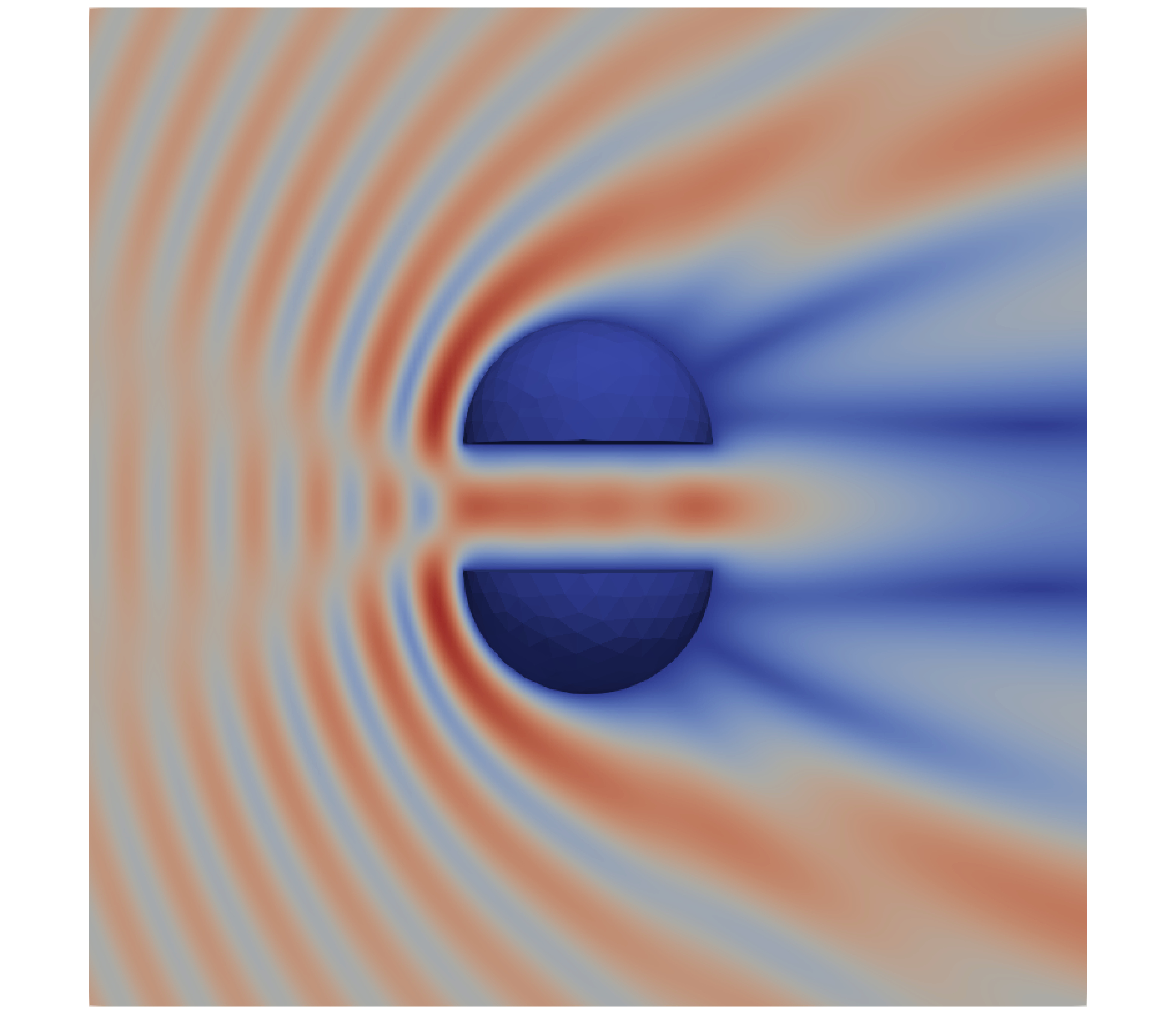
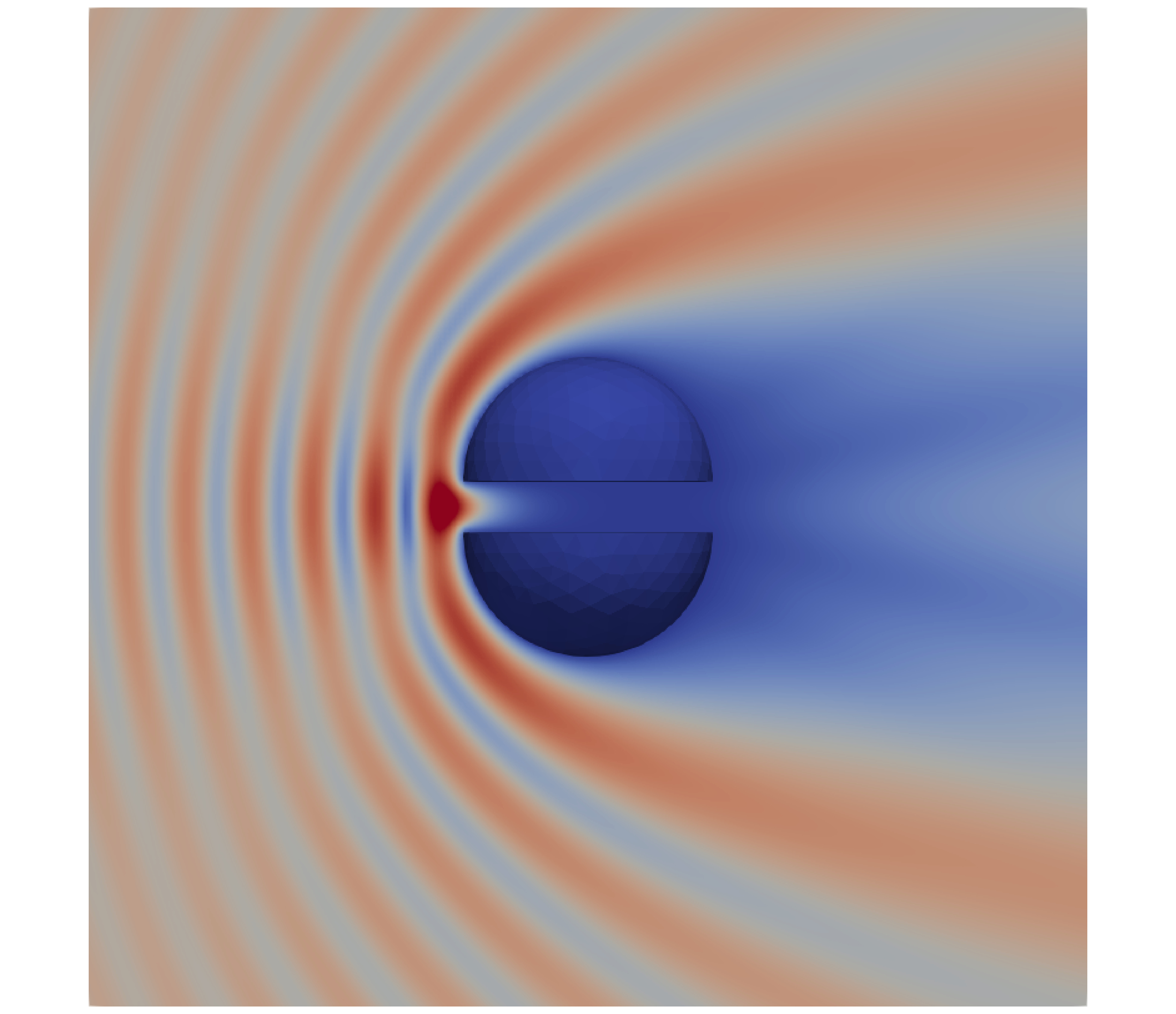
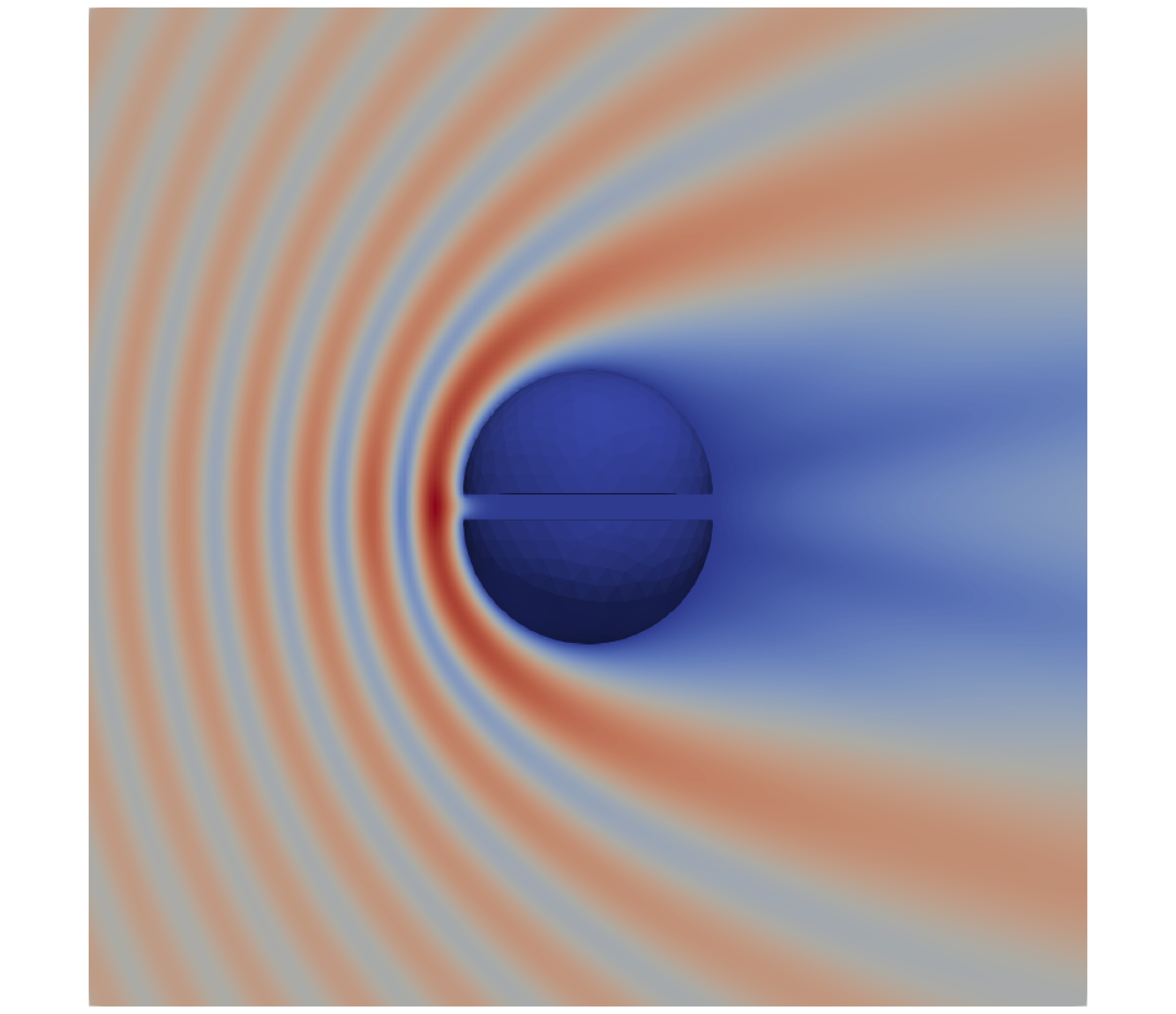
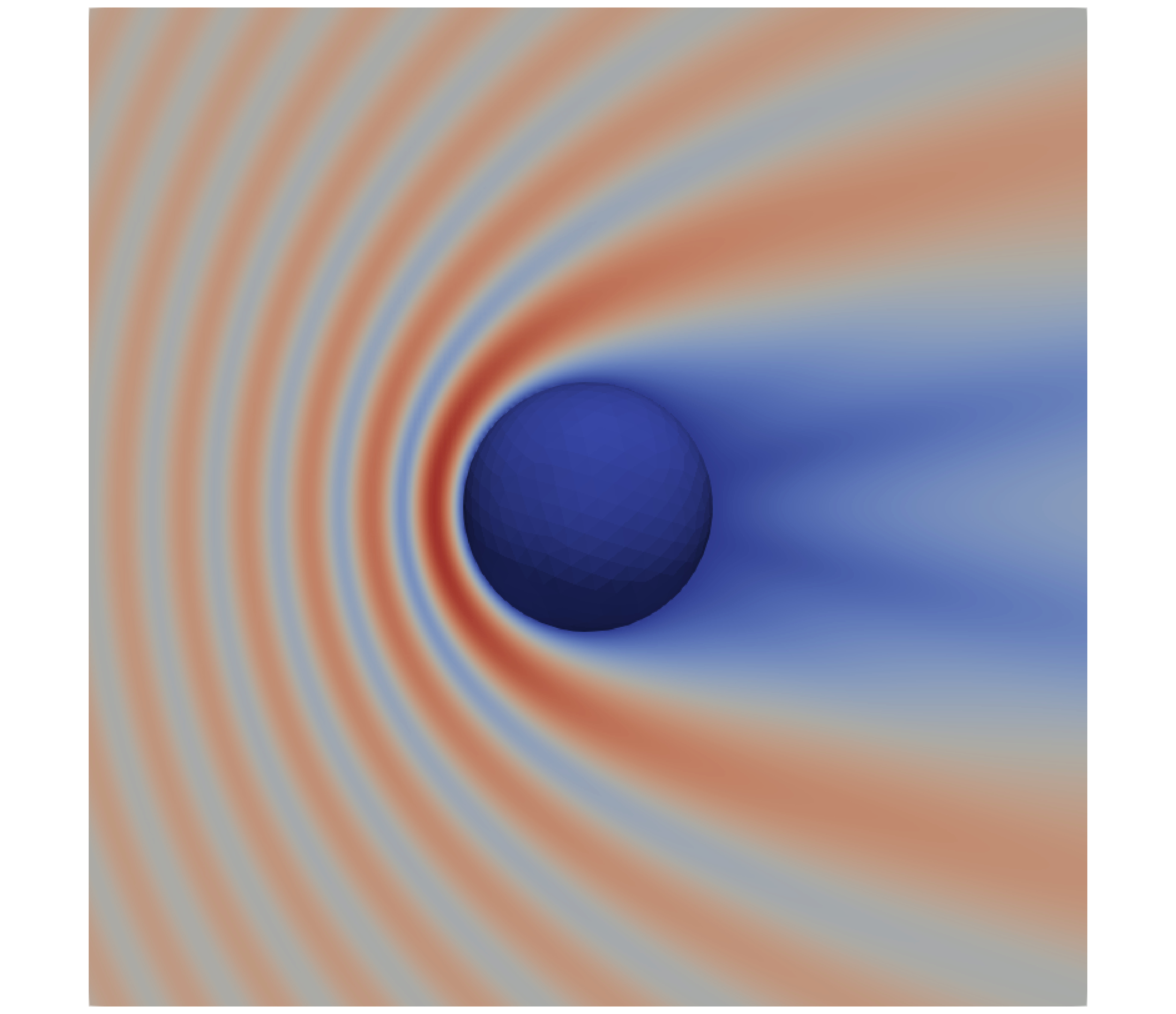
Collaborators
Matthieu Aussal (École Polytechnique), Francis Collino, Luiz Faria, Pierre Marchand & Houssem Haddar (Inria)
Software
fembem — C++ package to solve scattering problems with BEMs
singintpy — Python package for computing singular & near-singular integrals on quadratic triangles
Papers
2025 Convergence rates of curved boundary element methods for the 3D Laplace and Helmholtz equations arXiv
2023 Computing singular and near-singular integrals over curved boundary elements: The strongly singular case doi arXiv
2022 Computing weakly singular and near-singular integrals over curved boundary elements doi arXiv
Blog posts
2025 Convergence rates of curved boundary element methods (in prep.)
2023 Strongly singular integrals over curved elements
▶ Neural Network Approximation Theory
Background
I am interested in the mathematical properties of neural network models. In particular, I am trying to understand why and when neural networks break the curse of dimensionality.
For a real-valued function \(f\) in \(\mathbb{R}^d\) whose smoothness is characterized by some integer \(m\) (typically the order of integrable or bounded derivatives) and for some prescribed \(\epsilon>0\), one tries to show that there exists a neural network \(f_W\) of size \(W\) that satisfies, for some norm \(\Vert\cdot\Vert\), $$ \Vert f - f_W \Vert \leq \epsilon \quad \text{with} \quad W=\mathcal{O}(\epsilon^{-\frac{d}{m}}). $$ For deep neural networks, one also wants to find the asymptotic behavior of the depth \(L\) as a function of the error \(\epsilon\). (Note that the size \(W\) is the total number of parameters while the depth \(L\) is the number of hidden layers.) Results of this form are standard approximation results that suffer from the curse of dimensionality: for small dimensions \(d\), the size \(W\) of the network increases at a reasonable rate as \(\epsilon\) goes to zero; however, \(W\) grows geometrically with \(d\).
Results
In 2019, my collaborators and I showed that functions in the so-called Korobov spaces \(X^{2,p}(\Omega)\) of mixed derivatives in \(\Omega\subset\mathbb{R}^d\) can be approximated with error \(\epsilon\) by neural networks of depth \(L=\mathcal{O}(\vert\log\epsilon\vert\log d)\) and size \(W=\mathcal{O}(\epsilon^{-\frac{1}{2}}\vert\log\epsilon\vert^{\frac{3}{2}(d-1)+1}(d-1))\). The curse of dimensionality is lessened since \(d\) only affects logarithmic factors.
In 2020, we used the Kolmogorov–Arnold theorem to show that a subset of the continuous functions in \([0,1]^d\) can be approximated with error \(\epsilon\) by neural networks of depth and size \(L,W=\mathcal{O}(\epsilon^{-\log d})\).
Finally, in 2021, we considered generalized bandlimited functions \(f:[0,1]^d\rightarrow\mathbb{R}\) of the form $$ f(\boldsymbol{x}) = \int_{\mathbb{R}^d}F(\boldsymbol{w})K(\boldsymbol{w}\cdot\boldsymbol{x})d\boldsymbol{w}, $$ with \(\mathrm{supp}\,F\subset [-M,M]^d\), \(M\geq 1\), and for some integrable \(F:[-M,M]^d\rightarrow\mathbb{C}\) and analytic \(K:\mathbb{R}\rightarrow\mathbb{C}\). We proved that such functions can be approximated with error \(\epsilon\) by neural networks of depth \(L=\mathcal{O}(\log^2\epsilon^{-1})\) and size \(W=\mathcal{O}(\epsilon^{-2}\log^2\epsilon^{-1})\).
Collaborators
Qiang Du (Columbia), Haizhao Yang (Maryland)
Software
learnpy — Python package for supervised & unsupervised learning
Papers
2021 Deep ReLU networks overcome the curse of dimensionality for generalized bandlimited functions doi arXiv
2020 Error bounds for deep ReLU networks using the Kolmogorov–Arnold superposition theorem doi arXiv
2019 New error bounds for deep ReLU networks using sparse grids doi arXiv
Blog posts
2019 Deep networks and the Kolmogorov–Arnold theorem
▶ Spectral Methods
Background
Orthogonal polynomials lie at the heart of scientific computing. In the last ten years, there has been a renewed interest in their properties, which has contributed to the development of more efficient algorithms. In particular, asymptotic expansions and the exploitation of sparsity and low-rank structure in recurrence relations have been some of the key ingredients in the design of packages such as chebfun (MATLAB), approxfun (Julia), and dedalus (Python), which have automated the computation with orthogonal polynomials for approximating functions via interpolation, computing integrals via quadrature, and solving differential equations via spectral methods.
These packages are particularly relevant to the astrophysics, computational fluid dynamics, and biology communities, where simple geometries such as the sphere are prevalent. For example, nonlinear advection equations on the sphere, such as the shallow water equations, are of significant importance in atmospheric numerical modeling, while reaction-diffusion equations in a spherical shell are widely used as a model for convection patterns within the Earth's mantle, as well as for the modeling of morphogenesis in embryos. On top of these standard local differential equations, their nonlocal integral analogs are becoming more and more popular to model a wide range of phenomena in these communities.
Results (Ph.D.)
During my Ph.D. (2013–2017), I developed new numerical methods for simulating periodic physical phenomena.
The first year of my Ph.D. work was about the computation with periodic functions via approximations by trigonometric polynomials to machine precision, including the solution of nonlinear ODEs and ODE eigenvalue problems. For example, the Sturm–Liouville problem with periodic boundary conditions, $$ -\frac{d}{d\theta}\Big[p(\theta)\frac{du}{d\theta}\Big]+q(\theta)u(\theta)=\lambda w(\theta)u(\theta), $$ is discretized by \((-\mathbf{D}_N\mathbf{M}[p]\mathbf{D}_N + \mathbf{M}[q])\widehat{u} = \lambda\mathbf{M}[w]\widehat{u}\), where \(\mathbf{D}_N\) and \(\mathbf{M}[f]\) are the differentiation and multiplication by \(f\) matrices in Fourier space, and \(\widehat{u}\) is the vector of Fourier coefficients of \(u\).
During my second year, I investigated the computation of choreographies, periodic solutions in time of the \(n\)-body problem in which the bodies share a common orbit. The \(n\)-body problem describes the motion of point particles \(z_j(t)\in\mathbb{C}\), \(0\leq j\leq n-1\), through $$ z_j^{''}(t) - \sum_{\underset{i\neq j}{i=0}}^{n-1} \frac{z_i(t) - z_j(t)}{\big\vert z_i(t) - z_j(t) \big\vert^3} = 0, \;\, 0\leq j\leq n-1. $$ Since choreographies share a single orbit and are uniformly spread along it, these can be written as \(z_j(t) = q(t + 2\pi j/n)\), for some \(2\pi\)-periodic function \(q:[0,2\pi]\rightarrow\mathbb{C}\), and are minima of the action $$ \begin{align} A = \frac{n}{2}\int_0^{2\pi} \big\vert q'(t) \big\vert^2 dt + \frac{n}{2}\sum_{j=1}^{n-1} \int_0^{2\pi} \Big\vert q(t) - q\Big(t + \frac{2\pi j}{n}\Big) \Big\vert^{-1}dt. \end{align} $$ My coauthor and I proposed an algorithm based on interpolation and optimization for computing choreographies, which we implemented in the choreolab MATLAB package.

In my third year, I worked on stiff PDEs of the form
$$
u_t = \mathcal{L}u + \mathcal{N}(u), \quad u(0,\boldsymbol{x})=u_0(\boldsymbol{x}),
$$
where \(u(t,\boldsymbol{x})\) is a function of time \(t\) and space \(\boldsymbol{x}\), \(\mathcal{L}\) is a linear differential operator on a spatial domain in one, two or three periodic space dimensions and \(\mathcal{N}\) is a nonlinear operator of lower order. My colleague and I compared 30 high-order exponential integrators and showed that is it hard to beat one of the simplest integrators. Implementations in the chebfun MATLAB package allow one to compute the solutions of many PDEs quickly and accurately (spin code). We also implemented some of these integrators in the chebpy Python package.
The main project of my final year at Oxford was on stiff PDEs on the unit sphere of the form
$$
u_t = \mathcal{L}u + \mathcal{N}(u), \;\; u(t=0,x,y,z)=u_0(x,y,z).
$$
My coauthor and I proposed a novel fast algorithm based on a variant of the double Fourier sphere method and implicit-explicit time-stepping schemes (spinsphere code).

Results (Post-Ph.D.)
Building on these discretizations, I investigated biological applications during my postdoc at Columbia (2017–2019). We used the fast algorithms we developed to investigate pattern formation and explain symmetry breaking on the sphere with colleagues at Princeton.

My collaborators and I also introduced nonlocal diffusion operators on the sphere \(\mathbb{S}^2\), $$ \mathcal{L}_\delta u(\boldsymbol{x}) = \int_{\mathbb{S}^2} \rho_\delta(\vert\boldsymbol{x}-\boldsymbol{y}\vert) [u(\boldsymbol{y}) - u(\boldsymbol{x})]\,d\Omega(\boldsymbol{y}), $$ where\(\rho_\delta\) is a suitably defined (singular) nonlocal kernel. We presented algorithms for solving PDEs involving such operators with spectral accuracy in space and high-order accuracy in time. These are based on the diagonalization of the nonlocal operators, the high-accuracy computation of their eigenvalues, a fast spherical harmonic transform, and exponential integrators.
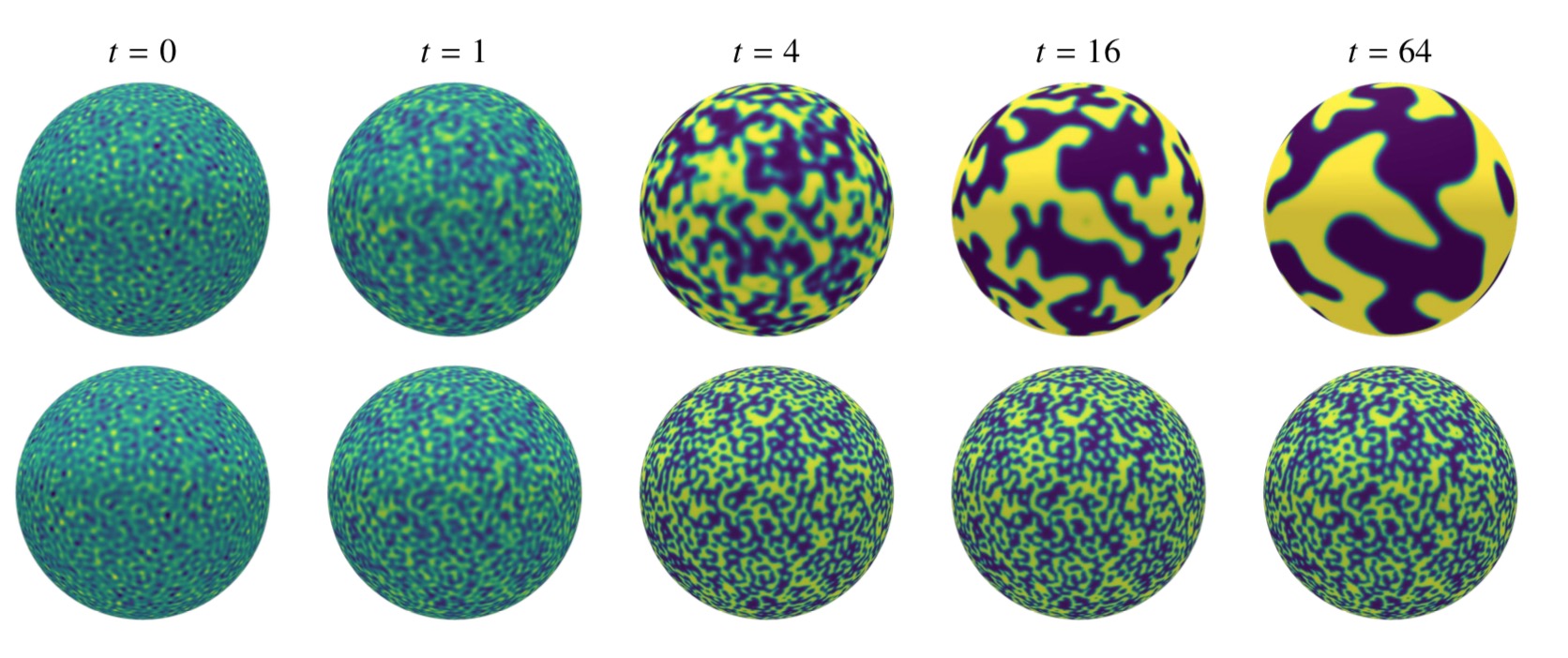
Several years later, in 2025, we introduced a nonlocal vector calculus on the unit two-sphere based on weakly singular integral operators. Within this framework, the operators were diagonalizable in scalar and vector spherical harmonics, which enabled the proof of the first nonlocal Stokes theorem on a curved surface. We also demonstrated that these nonlocal operators converged strongly to the classical differential operators of vector calculus as the interaction range tended to zero.
Collaborators
Qiang Du (Columbia), Yuji Nakatsukasa & Nick Trefethen (Oxford), Stanislav Shvartsman (Princeton), Mikael Slevinsky (Manitoba)
Software
chebfun — MATLAB package to approximate functions and solve PDEs
chebpy — Python package for solving PDEs
choreolab — MATLAB package for computing choreographies
Papers
2025 Nonlocal vector calculus on the sphere arXiv
2020 Solving periodic semilinear stiff PDEs in 1D, 2D and 3D with exponential integrators doi arXiv
2018 Spherical caps in cell polarization doi
2018 A spectral method for nonlocal diffusion operators on the sphere doi arXiv
2018 Fourth-order time-stepping for stiff PDEs on the sphere doi arXiv
2016 Computing hyperbolic choreographies doi arXiv
2016 Computing planar and spherical choreographies doi arXiv
2015 Extension of Chebfun to periodic functions doi arXiv
Blog posts
2025 Nonlocal vector calulus on the sphere (in prep.)
2020 Exponential integrators for stiff PDEs
2018 Computer-assisted proofs for PDEs
2018 Spherical caps in cell polarization
2018 Solving nonlocal equtions on the sphere
2018 Gibbs phenomenon and Cesàro mean
2017 Solving PDEs on the sphere
2017 When planets dance